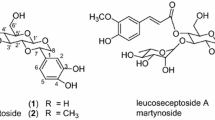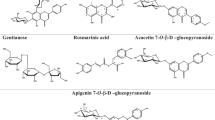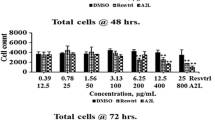Abstract
The molecular mechanisms of the ethylacetate (EtOAc) fraction from Orostachys japonicus (OJE) (including gallic acid, kaempferol, and quercetin) for anti-cancer activities in HepG2 cells were investigated. Apoptosis was detected using morphological observation of nuclear changes and investigation of phosphatidylserine exposure at the cytoplasmic membrane using FITC-Annexin V/PI staining. Activities of the apoptotic factors bcl-2, bax, cytochrome c, pro-caspase-3, 8, and 9, as well as MAPKs levels, were measured using western blotting. Some morphologic features of apoptosis were identified using confocal microscopy. OJE caused the expression of apoptotic proteins to change, as evidenced by an increased bax/bcl-2 ratio and increased expression of cytochrome c, and decreased expressions of pro-caspase-3, 8, and 9. After HepG2 cells were exposed to OJE, expressions of p-JNK and p-ERK1/2 increased in a dose dependent manner. OJE exhibits anti-cancer activity via apoptosis induction through a mitochondria dependent signaling pathway in HepG2 cells.
Similar content being viewed by others
References
Jemal A, Murray T, Ward E, Samuels A, Tiwari RC, Ghafoor A, Feuer EJ, Thun MJ. Cancer statistecs, 2005. CA-Cancer J. Clin. 55: 10–30 (2005)
Zhao YY, Shen X, Chao X, Ho CC, Cheng XL, Zhang Y, Lin RC, Du KJ, Luo WJ, Chen JY, Sun WJ. Ergosta-4,6,8(14),22-tetraen-3-one induces G2/M cell cycle arrest and apoptosis in human hepatocellular carcinoma HepG2 cells. Biochim. Biophys. Acta 1810: 384–390 (2011)
Kang SA, Park HJ, Kim MJ, Lee SY, Han SW, Leem KH. Citri reticulatae viride pericarpium extract induced apoptosis in SNU-C4, human colon cancer cells. J. Ethnopharmacol. 97: 231–235 (2005)
Kaufmann SH, Earnshaw WC. Induction of apoptosis by cancer chemotherapy. Exp. Cell Res. 256: 42–29 (2001)
Earnshaw WC, Martins LM, Kaufmann SH. Mammalian caspases: structure, activation, substrates, and functions during apoptosis. Ann. Rev. Biochem. 68: 383–424 (1999)
Han SI, Kim YS, Kim TH. Role of apoptotic and necrotic cell death under physiologic conditions. BMB Rep. 41: 1–10 (2008)
Sun XM, MacFarlane M, Zhuang J, Wolf BB, Green DR, Cohen GM. Distinct caspase cascades are initiated in receptor-mediated and chemical-induced apoptosis. J. Biol. Chem. 274: 5053–5060 (1999)
Brenner B, Koppenhoefer U, Weinstock C, Linderkamp O, Lang F, Gulbins E. Fas- or ceramide-induced apoptosis is mediated by a Rac1-regulated activation of Jun N-terminal kinase/p38 kinases and GADD153. J. Biol. Chem. 272: 22173–22181 (1997)
Schuchmann M, Galle PR. Sensitizing to apoptosis-sharpening the medical sword. J. Hepatol. 40: 335–336 (2004)
Park JC, Han WD, Park JR, Choi SH, Choi JW. Changes in hepatic drug metabolizing enzymes and lipid peroxidation by methanol extract and major compound of Orostacys japonicus. J. Ethnopharmacol. 102: 313–318 (2005)
Jeong Choi SY, Chung MJ, Seo WD, Shin JH, Shon MY, Sung NJ. Inhibitory effects of Orostachys japonicus extracts on the formation of N-Nitrosodimethylamine. J. Agr. Food Chem. 54: 6075–6078 (2006)
Lee JH, Lee SJ, Park S, Kim HK, Jeong WY, Choi JY, Sung NJ, Lee WS, Lim CS, Kim GS, Shin SC. Characterisation of flavonoids in Orostachys japonicus A. Berger using HPLC-MS/MS: Contribution to the overall antioxidant effect. Food Chem. 124: 1627–1633 (2011)
Jeong JH, Ryu DS, Suk DH, Lee DS. Anti-inflammatory effects of ethanol extract from Orostachys japonicus on modulation of signal pathways in LPS-stimulated RAW 264.7 cells. BMB Rep. 44: 399–404 (2011)
Lee HS, Ryu DS, Lee GS, Lee DS. Anti-inflammatory effects of dichloromethane fraction from Orostachys japonicus in RAW 264.7 cells: Suppression of NF-κB activation and MAPK signaling. J. Ethnopharmacol. 140: 271–276 (2011)
Ryu DS, Lee HS, Lee GS, Lee DS. Effects of the ethyl acetate extract of Orostachys japonicus on induction of apoptosis through the p53-mediated signaling pathway in human gastric cancer cells. Biol. Pharm. Bull. 35: 1–6 (2012)
Zhang YX, Kong CZ, Wang HQ, Wang LH, Xu CL, Sun YH. Phosphorylation of Bcl-2 and activation of caspase-3 via the c-Jun N-terminal kinase pathway in ursolic acid-induced DU145 cells apoptosis. Biochimie 91: 1173–1179 (2009)
Yoshida T, Konishi M, Horinaka M, Yasuda T, Goda AE, Taniguchi H, Yano K, Wakada M, Sakai T. Kaempferol sensitizes colon cancer cells to TRAIL-induced apoptosis. Biochem. Biophys. Res. Comm. 375: 129–133 (2008)
Lee DH, Szczepanski M, Lee YJ. Role of Bax in quercetin-induced apoptosis in human prostate cancer cells. Biochem. Pharmacol. 75: 2345–2355 (2008)
Hu W, Kavanagh JJ. Anticancer therapy targeting the apoptotic pathway. Lancet Oncol. 4: 721–729 (2003)
Yu YH, Kuo HP, Hsieh HH, Li JW, Hsu WH, Chen SJ, Su MH, Liu SH, Cheng YC, Chen CY, Kao MC. Ganoderma tsugae induces S phase arrest and apoptosis in doxorubicin-resistant lung adenocarcinoma H23/0.3 Cells via modulation of the PI3K/Akt signaling pathway. Evid. Based Compl. Alt. 2012: 371286 (2012)
Rello S, Stocker JC, Moreno V, Gamez A, Pacheco M, Juarranz A, Canete M, Villanuevea A. Morphological criteria to distinguish cell death induced by apoptotic and necrotic treatments. Apoptosis 10: 201–208 (2005)
Gross A, McDonnell JM, Korsmeyer SJ. Bcl-2 family members and the mitochondria in apoptosis. Genes Dev. 13: 1899–1911 (1999)
Scaffidi C, Fulda S, Srinivasan A, Friesen C, Li F, Tomaselli KJ, Debatin KM, Krammer PH, Peter ME. Two CD95 (APO-1/Fas) signaling pathways. EMBO J. 17: 1675–1687 (1998)
Herr I, Debatin KM. Cellular stress response and apoptosis in cancer therapy. Blood 98: 2603–2614 (2001)
Lin HH, Chen JH, Kuo WH, Wang CJ. Chemopreventive properties of Hebiscus Sabdariffa L. on human gastric carcinoma cells through apoptosis induction and JNK/p38 MAPK signaling activation. Chem. Biol. Interact. 165: 59–75 (2007)
Minden A, Karin M. Regulation and function of the JNK subgroup of MAP kinases. Biochim. Biophys. Acta 1333: 85–104 (1997)
Xia Z, Dickens M, Raingeaud J, Davis RJ, Greenberg ME. Opposing effects of ERK and JNK-p38 MAP kinases on apoptosis. Science 270: 1326–1331 (1995)
Chen YR, Zhou G, Tan TH. c-Jun N-Terminal kinase mediates apoptotic signaling induced by N-(4-hydroxyphenyl) retinamide. Mol. Pharmacol. 56: 1271–1279 (1999)
Author information
Authors and Affiliations
Corresponding author
Rights and permissions
About this article
Cite this article
Lee, GS., Lee, HS., Kim, SH. et al. Anti-cancer activity of the ethylacetate fraction from Orostachys japonicus for modulation of the signaling pathway in HepG2 human hepatoma cells. Food Sci Biotechnol 23, 269–275 (2014). https://doi.org/10.1007/s10068-014-0037-0
Received:
Revised:
Accepted:
Published:
Issue Date:
DOI: https://doi.org/10.1007/s10068-014-0037-0




